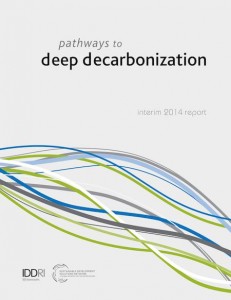UN committee releases international roadmap: Deep Decarbonization report to support UN Climate Talks
Posted by Ngaire
8 July, 2014: A United Nations (UN) committee has released a report which will pave the way for a UN climate change summit in New York this September, in the lead up to international climate change negotiations at COP 21 in Paris, December 2015.
The interim report seeks input and outlines pathways for major industrial economies to cut their carbon emissions by mid-century, calling for broad cooperation and “bold” action or the world will face dangerous and irreversible climate disruption.
UN Secretary-General Ban Ki-moon, said, “We know that we are not on track, and time is not on our side,” Mr Ban warned during a Headquarters press conference to launch the Deep Decarbonization Pathway Project report, produced by leading research institutes in 15 countries, is the first global cooperative program to identify practical pathways to a low-carbon economy by 2050.
The report compiled by the Sustainable Development Solutions Network, established by the UN chief in 2012, emphasizes three key pillars: energy efficiency, low-carbon electricity and fuel switching. It also outlines steps countries can take to meet internationally agreed target of limiting the increase in global mean surface temperature to less than 2 degrees Celsius.
“People need to understand why decarbonisation is necessary. They need to know it is possible. And they need to see that cutting emissions can benefit economics and people’s well-being.“
The full article and a video recording of the press conference is available at the UN News Centre.
Details: Deep Decarbonization report charts pathways to low carbon in major emitting countries
A UN committee has released a report entitled, Deep Decarbonization Pathways, which shows how the major emitting countries can cut their carbon emissions by mid-century in order to prevent dangerous climate change.
The study looks at the world’s 15 biggest economies: America, Australia, Brazil, Britain, Canada, China, France, Germany, India, Indonesia, Japan, Mexico, Russia, South Africa, and South Korea, which between them account for 70% of global emissions.
The report, produced cooperatively by leading research institutes, is the first global cooperative program to identify practical pathways to a low-carbon economy by 2050.
The Deep Decarbonization Pathways Project (DDPP) interim report is being presented to the French government, as host of the 2015 United Nations Framework Convention on Climate Change (UNFCCC) climate conference. The interim report supports the UN Climate Summit on September 23, 2014.
The full DDPP report will be presented in the spring of 2015.
“The Deep Decarbonization Pathways Project report is an effort to demonstrate how countries can contribute to achieving the globally agreed target of limiting global temperature rise to below 2 degrees,” said Secretary-General Ban. “Ambitious national action is critical to averting dangerous climate change. This report shows what is possible.”
The report aims to help countries to set bold targets as they go into next year’s climate negotiations. It is issued midway in the project in order to support the deliberations at the UN Climate Summit on 23 Sept 2014. The report is a joint project of independent research teams in 15 countries, with around 30 participating scientific institutions.
The International Energy Agency (IEA) and the World Business Council on Sustainable Development (WBCSD) also brought their expertise to the project. These institutions convened under the auspices of the Sustainable Development Solutions Network, an initiative of Columbia University’s Earth Institute for the UN, and the Institute for Sustainable Development and International Relations, a nonprofit policy research institute based in Paris.
“The world has committed to limit warming to below 2 degrees C, but it has not committed to the practical ways to achieve that goal,” said Jeffrey Sachs, director of the SDSN and of Columbia University’s Earth Institute. “This report is all about the practicalities. Success will be tough – the needed transformation is enormous – but is feasible, and is needed to keep the world safe for us and for future generations. One key message is to invest in developing the low-carbon technologies that can make a difference.”
Despite the global pledge to keep warming below 2 degrees, the world is currently on a trajectory to an increase of 4 degrees or more. According to the 2014 report of the Intergovernmental Panel on Climate Change (IPCC), such a rise would pose dangers that might exceed the ability of societies to adapt, including crop failures, drastic sea-level rise, migration of diseases, and extinctions of ecosystems. Some leading climate scientists, including the longtime NASA chief climate scientist and now Columbia University professor James Hansen, stress that even a 2-degree rise would pose great dangers, and that we should aim for less. But staying within the 2-degree limit is essential to maintain climate change within the boundaries of manageable risks.
The International Energy Agency’s chief economist, Fatih Birol, said: “The issue is to convince the world that the future is as important as the present. Paris 2015 may well be our last hope.”
The 15 national pathways all demonstrate the importance of three pillars for the deep decarbonization of energy systems:
- greatly increased energy efficiency and energy conservation in all energy end-use sectors (including buildings, transport and industry);
- the decarbonization of electricity, achieved by harnessing renewable energy sources such as wind and solar, as well as nuclear power, and/or the capture and sequestration of carbon emissions from fossil-fuel burning; and
- replacing the fossil fuels that drive transport, heating and industrial processes with a mix low-carbon electricity, sustainable biofuels and hydrogen.
Countries have several options to achieve deep decarbonization, based on differences in the resource base and public preferences. Yet the three pillars are the common platform for building the deep decarbonization of energy systems in every country.
Perhaps most importantly, the interim results demonstrate the critical importance of preparing national DDPs to 2050. “These pathways, and the discussion over their results and assumptions, are an essential tool for learning and problem solving,” said Emmanuel Guerin, associate director of the SDSN and senior project manager of the DDPP. “They are crucial to outline the long-term visions of deep decarbonization and shape the expectations of countries, businesses and investors about future socio-economic development opportunities.”
Laurence Tubiana, the founder of IDDRI and the special representative of the French government for the 2015 climate conference, said it is her “hope that this interim report, and the full report to be published next spring, will make a useful contribution to the structure and content of the debate by spurring the design and international comparison of national DDPs and by promoting the needed global cooperation to achieve them.”
Partial extracts from the report: Australia’s emissions
The chapter on Australia was compiled by authors from ANU, ClimateWorks Australia, the CSIRO and Victoria University.
The proposed cumulative emissions to 2050 are compatible with Australia’s carbon budget recommended by Australia’s Climate Change Authority, an independent body established under the Climate Change Act 2011.
The Deep Decarbonization report recognises Australia as a mid-sized developed economy with high per capita greenhouse gas emissions despite abundant renewable and non-renewable resources.
The report identifies that Australia’s economy is highly emissions-intensive due to the extensive use of coal in electricity supply which accounts for two thirds of greeenhouse gas emissions. Other drivers include a history of low cost enery, the role of agriculture in the economy (15% of total emissions including methane emissions from livestock) and long distance transport requirements. Mining and manufacturing contribute over one third of Australia’s total greenhouse gas emissions (a third of which are fugutive emissions).
On the positive side, the emissions intensity of Australia’s GDP has nearly halved. Although emissions from energy use has risen over two decades, this has been roughly offset by reduced deforestation and increased plantation forestry.
Since 2008/09, expansions in renewable energy, improved energy efficiency and rising electricity prices have seen emissions from fuel combustion stablize.
Pathways to decarbonize Australia’s economy
The report acknowledges there are many options available to Australia. The options described draw on existing analyses and feedback from over 40 industry and academic experts. However, views diverge on options such as carbon capture and storage (CCS), carbon forestry ad bioenergy.
The report states, “Australia can maintain economic growth and prosperity, and decarbonize by 2050. The results from the illustrative pathway show that betweennow and 2050, real GDP grows at 2.4% per year on average, resultig in an economy nearly 150% larger than today.”
Australia’s energy emissions
Pillars of decarbonization (energy) include structural change (including changes in commodity demand, consumer preferences, growth in the service sector and plateauing of car travel). Other strategies include fuel switching, energy efficiency, electrification of transport (including a shift to rail and away from diesel), changes to industrial processes and fuel switching to gas or biomass where possible.
Energy transformation towards 100% renewable grid-integrated electricity with some gas fired electricity (particularly in remote areas) may be necessary as well as significant shifts towards bioenergy.
Non-energy emissions
Reductions in industrial processes and fugitive emissions may deliver considerable reductions as well as best-practice farming and livestock production. There is also potential to offset emissions by planting and carbon farming techniques.
Buildings
Greenhouse gas emissions from commercial and residential buildings reduce by 95% to 2050 due to significant energy efficiency, electrification of direct fuel use (e.g. gas for heating), and the use of decarbonized electricity. Energy use per square meter of commercial building and per residential dwelling decreases by approximately 50%. There is strong growth in distributed, grid integrated electricity generation, in particular rooftop solar PV.
Transport
A substantial shift from internal combustion engine vehicles to electric and hybrid vehicles, and to a lesser extent hydrogen fuel cell vehicles, results in over 70% improvement in the energy efficiency of cars and light commercial vehicles. Gas is used extensively for road freight. As a result, oil use for road transport decreases by 85% between 2012 and 2050 while vehicle kilometers travelled nearly double. Biofuels replace 50% of oil use in aviation, as this is one of the only decarbonization options currently available for this sector.
Agriculture and forestry
Soil and livestock emissions are reduced through the implementation of best practice farming techniques, in particular for beef (e.g. intensification of breeding, improvement in feeding and pasture practices, as well as enhanced breeding and herd selection for lower livestock methane emissions). In addition, a small relative reduction in beef demand is expected to result from increases in beef prices in a decarbonized world. Together, these factors drive a 45% reduction in emissions intensity of agricultural activity.
Australia has great potential to offset emissions via forestry bio-sequestration. Under price incentives for afforestation, large shifts in land use from agricultural land (in particular grasslands) to carbon forestry would become profitable. However, this would require significant development of supply chains as well as regional capabilities and workforces.
Challenges for Australia
There are various technological, economic, social and political challenges to implementing decarbonization pathways in Australia. However this report focuses on the technological challenges, which include:
– Demonstrating the viability of decarbonization technologies (e.g. CCS, energy storage, emerging renewables such as wave and enhanced geothermal systems, and rigorous carbon forestry accounting standards); and
– Developing the supply chains and workforce for new technologies and services (e.g. bioenergy, carbon forestry technologies and accounting methods).
Co-benefits
These include economic and technology leadership gains, biodiversity improvements and co-benefits include better air quality and improved health due to reduced fossil fuel use, increased production levels due to improved energy efficiency, and workforce productivity gains in more naturally lit and energy efficient workplaces.
Enabling conditions
The fundamental enabler for the decarbonization of the Australian economy is the simultaneous decarbonization of all other major industrialized countries.
Near-term priorities
Australia faces the risk of locking in energy-intensive assets, especially for new vehicles, buildings, industrial plants, mines, and power stations.
Some key areas of focus include:
- R&D
- Electrification of transport
- CCS
- Zero-carbon energy industries
- Energy efficiency programs
- Development of carbon farming technologies
- Biofuel and bio-sequestration options
- Reducing food waste and food production emissions
Transition to a decarbonized world will require new forms of international collaboration, and a concerted approach to collaborative national knowledge creation and problem solving.




